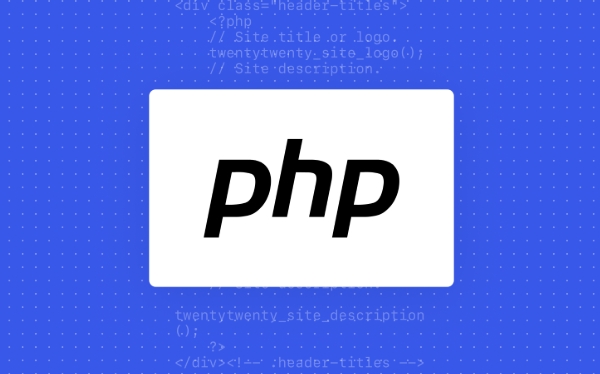How do union types work in PHP 8 function parameters?
Jul 06, 2025 am 02:45 AMPHP 8 introduces union types to support native syntax, allowing function parameters to accept multiple types. 1. Use the "|" symbol to define union types, such as int|string; 2. Supports primitive types, objects and nullable types without additional tags; 3. It is often used to flexibly input while maintaining type safety, such as processing user IDs or optional values; 4. Pay attention to the type check order, avoid duplicate types, and do not support PHP 8.0 return types. Union types improve code clarity, but still have limitations.

Union types in PHP 8 allows you to specify that a function parameter can accept more than one type. Before PHP 8, the only way to do this was by using comments (like @param ) for documentation, but now it's supported natively with actual syntax.

Basic Syntax
You use the pipe symbol ( | ) between types to define a union. For example:

function setCount(int|string $value): void {
// ...
} In this case, the function setCount accepts either an int or a string . If any other type is passed, PHP will throw a TypeError .
This works not just for primitive types like int , string , and bool , but also for objects and even nullable types.

Note: If you're using
nullas part of a union, you don't need to mark the parameter as nullable separately. For example:function setName(string|null $name): void {}This already allows
null, so there's no need to write?stringhere — in fact, doing both would be redundant and cause a parse error.
Common Use Cases
Union types are useful when a function needs to handle flexible input types while still keeping some level of type safety.
For example, imagine a function that can take either a user ID (as an integer) or a User object:
function loadUser(int|User $identifier): ?User {
if ($identifier instanceof User) {
return $identifier;
}
return User::findById($identifier);
} This makes the code clearer without having to rely on mixed or object types, which are too vague.
Another typical scenario is allowing optional values ??through null :
function formatText(string|null $text): string {
return $text ? strtoupper(trim($text)) : '';
} Here, we're explicitly stating that $text may be omitted or set to null, and we handle that case directly in the function body.
Things to Watch Out For
There are a few gotchas when working with union types:
Type checking order matters
When checking types inside the function, always check the most specific types first. For example, if you havearray|Traversable, make sure to check forTraversablebeforearray, sinceTraversableis more specific and won't match arrays.No duplicate types allowed
Writing something likeint|intwill result in a syntax error. You must list each type once.Union types don't work with return types yet
As of PHP 8.1, union types are supported in return types too, but if you're still on PHP 8.0, you'll have to stick to a single return type or use docblocks for documentation.
Also remember that union types are checked strictly at runtime. So if you pass a value that doesn't exactly match one of the types in the union, PHP will throw an error instead of trying to coerce the value.
Summary
Union types in PHP 8 gives you a clean and powerful way to define functions that accept multiple valid types without sacrificing type safety. They're especially handy when dealing with optional parameters, polymorphic behavior, or APIs that expect flexible inputs.
They're not perfect — especially if you're still on PHP 8.0 and can't use them in return types — but they definitely improve code clarity compared to older practices like using mixed or relying solely on docblocks.
That's basically how they work. Not too bad once you get used to the syntax.
The above is the detailed content of How do union types work in PHP 8 function parameters?. For more information, please follow other related articles on the PHP Chinese website!

Hot AI Tools

Undress AI Tool
Undress images for free

Undresser.AI Undress
AI-powered app for creating realistic nude photos

AI Clothes Remover
Online AI tool for removing clothes from photos.

Clothoff.io
AI clothes remover

Video Face Swap
Swap faces in any video effortlessly with our completely free AI face swap tool!

Hot Article

Hot Tools

Notepad++7.3.1
Easy-to-use and free code editor

SublimeText3 Chinese version
Chinese version, very easy to use

Zend Studio 13.0.1
Powerful PHP integrated development environment

Dreamweaver CS6
Visual web development tools

SublimeText3 Mac version
God-level code editing software (SublimeText3)
 PHP Variable Scope Explained
Jul 17, 2025 am 04:16 AM
PHP Variable Scope Explained
Jul 17, 2025 am 04:16 AM
Common problems and solutions for PHP variable scope include: 1. The global variable cannot be accessed within the function, and it needs to be passed in using the global keyword or parameter; 2. The static variable is declared with static, and it is only initialized once and the value is maintained between multiple calls; 3. Hyperglobal variables such as $_GET and $_POST can be used directly in any scope, but you need to pay attention to safe filtering; 4. Anonymous functions need to introduce parent scope variables through the use keyword, and when modifying external variables, you need to pass a reference. Mastering these rules can help avoid errors and improve code stability.
 How to handle File Uploads securely in PHP?
Jul 08, 2025 am 02:37 AM
How to handle File Uploads securely in PHP?
Jul 08, 2025 am 02:37 AM
To safely handle PHP file uploads, you need to verify the source and type, control the file name and path, set server restrictions, and process media files twice. 1. Verify the upload source to prevent CSRF through token and detect the real MIME type through finfo_file using whitelist control; 2. Rename the file to a random string and determine the extension to store it in a non-Web directory according to the detection type; 3. PHP configuration limits the upload size and temporary directory Nginx/Apache prohibits access to the upload directory; 4. The GD library resaves the pictures to clear potential malicious data.
 Commenting Out Code in PHP
Jul 18, 2025 am 04:57 AM
Commenting Out Code in PHP
Jul 18, 2025 am 04:57 AM
There are three common methods for PHP comment code: 1. Use // or # to block one line of code, and it is recommended to use //; 2. Use /.../ to wrap code blocks with multiple lines, which cannot be nested but can be crossed; 3. Combination skills comments such as using /if(){}/ to control logic blocks, or to improve efficiency with editor shortcut keys, you should pay attention to closing symbols and avoid nesting when using them.
 How Do Generators Work in PHP?
Jul 11, 2025 am 03:12 AM
How Do Generators Work in PHP?
Jul 11, 2025 am 03:12 AM
AgeneratorinPHPisamemory-efficientwaytoiterateoverlargedatasetsbyyieldingvaluesoneatatimeinsteadofreturningthemallatonce.1.Generatorsusetheyieldkeywordtoproducevaluesondemand,reducingmemoryusage.2.Theyareusefulforhandlingbigloops,readinglargefiles,or
 Tips for Writing PHP Comments
Jul 18, 2025 am 04:51 AM
Tips for Writing PHP Comments
Jul 18, 2025 am 04:51 AM
The key to writing PHP comments is to clarify the purpose and specifications. Comments should explain "why" rather than "what was done", avoiding redundancy or too simplicity. 1. Use a unified format, such as docblock (/*/) for class and method descriptions to improve readability and tool compatibility; 2. Emphasize the reasons behind the logic, such as why JS jumps need to be output manually; 3. Add an overview description before complex code, describe the process in steps, and help understand the overall idea; 4. Use TODO and FIXME rationally to mark to-do items and problems to facilitate subsequent tracking and collaboration. Good annotations can reduce communication costs and improve code maintenance efficiency.
 Quick PHP Installation Tutorial
Jul 18, 2025 am 04:52 AM
Quick PHP Installation Tutorial
Jul 18, 2025 am 04:52 AM
ToinstallPHPquickly,useXAMPPonWindowsorHomebrewonmacOS.1.OnWindows,downloadandinstallXAMPP,selectcomponents,startApache,andplacefilesinhtdocs.2.Alternatively,manuallyinstallPHPfromphp.netandsetupaserverlikeApache.3.OnmacOS,installHomebrew,thenrun'bre
 How to access a character in a string by index in PHP
Jul 12, 2025 am 03:15 AM
How to access a character in a string by index in PHP
Jul 12, 2025 am 03:15 AM
In PHP, you can use square brackets or curly braces to obtain string specific index characters, but square brackets are recommended; the index starts from 0, and the access outside the range returns a null value and cannot be assigned a value; mb_substr is required to handle multi-byte characters. For example: $str="hello";echo$str[0]; output h; and Chinese characters such as mb_substr($str,1,1) need to obtain the correct result; in actual applications, the length of the string should be checked before looping, dynamic strings need to be verified for validity, and multilingual projects recommend using multi-byte security functions uniformly.
 Learning PHP: A Beginner's Guide
Jul 18, 2025 am 04:54 AM
Learning PHP: A Beginner's Guide
Jul 18, 2025 am 04:54 AM
TolearnPHPeffectively,startbysettingupalocalserverenvironmentusingtoolslikeXAMPPandacodeeditorlikeVSCode.1)InstallXAMPPforApache,MySQL,andPHP.2)Useacodeeditorforsyntaxsupport.3)TestyoursetupwithasimplePHPfile.Next,learnPHPbasicsincludingvariables,ech






